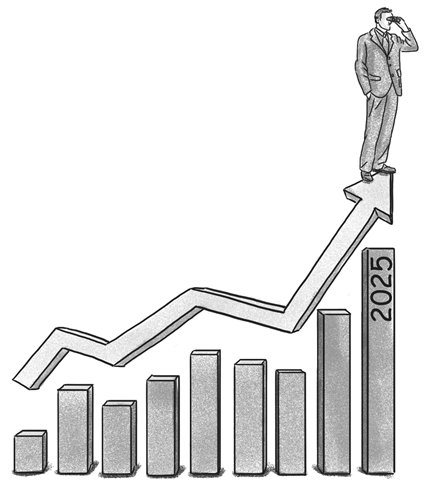HOME >> BUSINESS
China faces short-term pressure, can expect to become a high-income economy by 2025
Source:Global Times Published: 2019/8/12 19:28:39

Illustration: Xia Qing/GT
Long-term challenges and risks may be more severe than the short-term ones for China, but China's long-term development can still be seen as optimistic.
China's short-term goal, which is to build a moderately prosperous society in all respects by 2020 and double its GDP next year, can be expected to be achieved.
China faces certain challenges in its long-term developments, including overcoming the middle income trap, maintaining a long-term medium to high growth speed, and meeting the standards of high-income economies by 2025.
Long-term economic growth is usually analyzed in terms of prime movers, capital formation and factors of production, which can be broken down into simpler terms as people, money and power. These three aspects are all currently facing risks.
China's savings have been greater than its investment in the past 20 years, which is reflected in the surplus in accounts, social insurance and pensions.
However, as China's population ages, older generations gradually retire from work and stop saving as much money as they used to, and younger generations consume heavily and live from paycheck to paycheck. These factors often cause a current account deficit, which may transform China from a capital exporting country to a capital importing country.
In addition, the globalization dividend, China's urbanization, and the global industrial chain which enters China in the process of globalization, help China continue to improve its manufacturing efficiency. But China is also facing a further spread of trade frictions and the rise in labor prices.
Therefore, China needs to attract further foreign investment to make up the current account deficit and insufficient savings rate, and turn the assets of domestic, state-owned enterprises (SOEs) profitable.
China should also repair the problem of pension income running behind its expenses by increasing pension profit and revitalizing pensions' financial conditions through market-based methods, and carry out further reforms for the domestic real economy.
The household registration system and the development of urban agglomeration promoted by intelligent urbanization still have huge potential.
Despite the challenges China is facing, it still has many ways to deal with these tasks. For example, many companies are considering investing in Vietnam and other countries, but research shows that moving outward is a time-consuming, difficult, and costly business.
If a company moves to Vietnam or to other Southeast Asian economies, initial costs will usually increase by about 10 percent when compared to staying in China. Plus, Vietnam cannot replace the huge trade volume China has as its size is relatively small.
The decline in savings caused by its population has transformed China from a saver to a debtor. If China's savings rate is steadily declining, the second half of the year may be the first time that the current account deficit will emerge.
However, China's growth potential is very large as foreign investors hold less than 3 percent of China's bond and stock markets at present. If China acts properly, according to the current reform road map and timetable proposed by regulatory authorities, the annual stock and bond markets' inflows are estimated to reach 100 billion yuan ($14.4 billion) respectively. Plus, equity funds and pension funds will gradually allocate yuan assets.
The allocation of yuan assets in the global equity fund has been higher than the Australian dollar up to this year. This is not compatible with the forthcoming implementation of financial reform and opening-up, but could make up for the insufficient money and low saving rate issues.
The bond markets that flowed into China, particularly the national debt market, were nearly $80 billion last year, and this year they were close to $200 billion. There has been great progress in this regard.
Finally, as for issues such as domestic assets and the local debt crisis, China has an opportunity compared to other economies, to enhance the incentive mechanism and management system to further increase the abilities of SOEs. This can be achieved by adopting mixed ownership in local SOEs to give them more incentives, and then dividing the equity of SOEs into social security, which can completely offset the possibility that China's social security will not be able to make ends meet in the future.
If China gives full play to foreign capital and state-owned assets, what can be relied on to improve productivity in the next stage? There are usually two types of urbanization, and neither has been completed.
One is the simple urbanization of housing, industry and infrastructure, as well as institutionalized, technologically applied, and smart urban agglomerations of urbanization.
Some people are concerned that cities with populations over five million may suffer urban malaise; Issues such as traffic congestion, pollution and even some social problems could arise. But now they can solve or avoid these problems effectively through smart cities.
China needs to build its own urban agglomerations. Besides the cities of the Guangdong-Hong Kong-Macao Greater Bay Area and the Pearl River Delta in South China, urban agglomeration can hardly be seen in Chinese cities.
Urban agglomeration in China has huge market potential if cities can be interconnected and the household registration system can be carried out.
If China can deal with its challenges in an appropriate way, it is very likely it will overcome the middle-income trap. Although there is pressure in the short term, China can expect to become a high-income economy by around 2025.
The article was compiled based on a recent speech by Xing Ziqiang, Morgan Stanley's chief economist for the Chinese market, at a forum in Shenzhen. bizopinion@globaltimes.com.cn
Posted in: INSIDER'S EYE